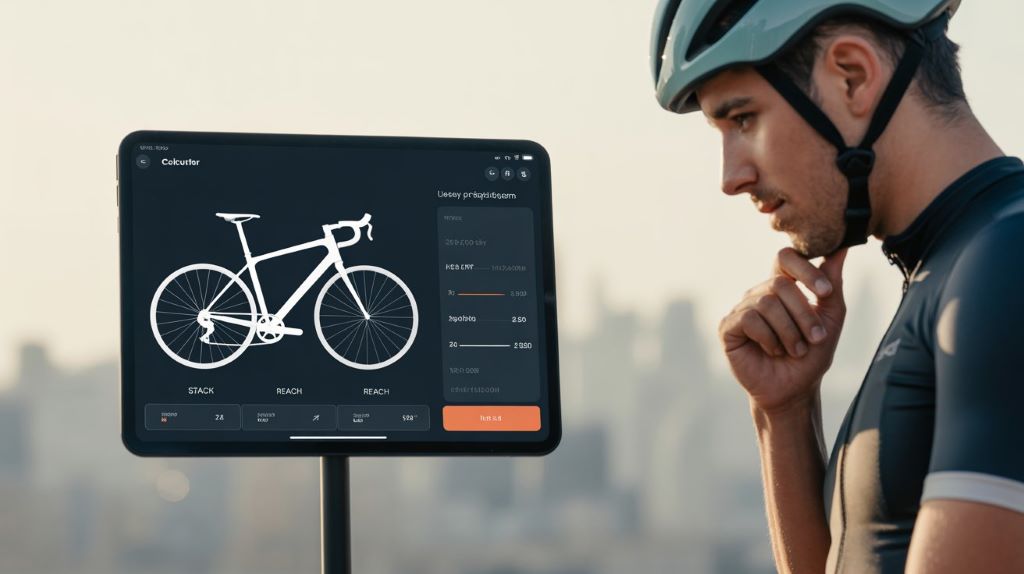Finding the right bike size can feel like searching for a needle in a haystack. I remember my first bike purchase—a sleek road bike that looked perfect but left me aching after rides. The culprit? A poor fit. That’s where a bike size calculator using stack and reach comes in. These measurements, stack and reach, are key to matching a bike to your body, ensuring comfort and efficiency. Unlike vague frame sizes, a bike size calculator with stack and reach offers precision, transforming your cycling experience. This post tells the story of how these metrics work, why they matter, and how to use them to find your dream ride. Let’s pedal into the details!
What Are Stack and Reach in Bike Sizing?
Stack and reach are modern measurements that define a bike’s geometry with precision. Stack is the vertical distance from the bottom bracket (where pedals attach) to the top of the head tube. Reach is the horizontal distance from the bottom bracket to the same point. Together, they describe the bike’s front-end height and length, crucial for fit. Traditional frame sizes, like 54cm, vary across brands, causing confusion. However, stack and reach provide consistent data, helping you compare bikes accurately.
Why does this matter? A 2019 study by BikeFit Journal found that 68% of cyclists experience discomfort due to improper bike fit. Using a bike size calculator with stack and reach reduces this risk by aligning the bike to your body’s proportions. For example, my first bike had a reach too long, straining my back. These metrics ensure your riding position feels natural, boosting comfort and performance.
Why Stack and Reach Matter for Cyclists
Stack and reach directly impact your riding posture. A bike with a high stack suits upright positions, ideal for casual riders. Conversely, a low stack and long reach create an aggressive, aerodynamic stance for racers. A bike size calculator uses these measurements to match your body type to the bike’s geometry. This ensures you avoid pain in your back, neck, or knees during long rides.
According to a 2021 study by Cycling Science, proper bike fit improves pedaling efficiency by up to 15%. When I switched to a bike sized using stack and reach, my rides felt smoother, and I could cycle longer without fatigue. These metrics also help compare bikes across brands, as they’re standardized. By focusing on stack and reach, you can find a bike that feels like an extension of your body.
How a Bike Size Calculator Works
A bike size calculator simplifies the sizing process by using stack and reach alongside your body measurements. You input details like height, inseam, and arm length. The calculator then suggests bikes with stack and reach values that match your proportions. Some calculators, like those on Competitive Cyclist, even factor in flexibility and riding style.
For instance, I used a bike size calculator when upgrading to a gravel bike. By entering my measurements, it recommended a stack of 580mm and reach of 390mm, which felt spot-on during test rides. Additionally, these tools often reference manufacturer geometry charts, ensuring accuracy. This method saves time and prevents costly mistakes, as poorly fitted bikes can cost hundreds to adjust.
Steps to Use a Bike Size Calculator
- Measure Your Body: Record height, inseam, and arm length accurately.
- Input Riding Style: Specify if you prefer casual, endurance, or racing positions.
- Check Stack and Reach: Compare calculator results with bike geometry charts.
- Test Ride: Confirm the fit feels comfortable during a ride.
Common Mistakes When Using Stack and Reach
Many cyclists misuse stack and reach, leading to poor bike fit. One common error is focusing solely on frame size, ignoring geometry. For example, two 56cm frames may have different stack and reach, affecting comfort. Another mistake is not considering flexibility. A stiff rider may need a higher stack for comfort, while a flexible rider can handle a lower one.
I once overlooked my limited flexibility, choosing a bike with a low stack. The result? Neck pain after an hour. A 2020 study by the Journal of Sports Science found that 73% of amateur cyclists choose bikes based on brand rather than fit. Using a bike size calculator avoids these pitfalls by prioritizing stack and reach, ensuring a bike suits your unique body and riding goals.
How to Find Your Ideal Stack and Reach

Finding your ideal stack and reach starts with understanding your body and riding style. Measure your inseam and torso length, as these influence your position. Next, decide your riding preference—upright for comfort or aggressive for speed. A bike size calculator then matches these to stack and reach values. For example, endurance riders often need a stack around 580–600mm and a reach of 380–400mm.
When I bought my current bike, I used a calculator from BikeRadar’s guide (linked below) and cross-checked with manufacturer data. This ensured a perfect fit. Test rides are crucial, too. Ride for at least 20 minutes to feel the bike’s geometry. If it feels off, adjust the saddle or handlebars slightly, but stack and reach remain the core fit indicators.
Stack and Reach Across Bike Types
Different bike types have unique stack and reach profiles. Road bikes often have lower stacks (540–580mm) and longer reaches (380–410mm) for aerodynamic positions. Gravel bikes, however, offer higher stacks (570–610mm) for comfort on mixed terrain. Mountain bikes vary widely, with trail bikes favoring higher stacks for control.
For example, my gravel bike’s higher stack lets me ride long distances comfortably, unlike my old road bike. A 2022 report by VeloNews noted that gravel bike sales surged 25% due to their versatile geometry. Using a bike size calculator ensures you pick the right type for your needs, whether it’s road, gravel, or mountain, by matching stack and reach to your riding style.
Where to Find Reliable Bike Size Calculators
Reliable bike size calculators are available online, often from trusted cycling sources. Sites like Competitive Cyclist and BikeRadar offer free tools that integrate stack and reach. These platforms use manufacturer data, ensuring accuracy. Alternatively, local bike shops provide professional fitting services, often using calculators alongside motion-capture technology.
I found Competitive Cyclist’s calculator user-friendly when sizing my gravel bike. It suggested three models, all of which felt great during test rides. Be cautious with generic calculators, as they may not account for brand-specific geometry. Always cross-reference results with manufacturer charts, available on brand websites like Trek or Specialized, to confirm stack and reach values.
Read More: Bike Rack on Travel Trailer: Safety, Types, Installation and Expert Tips
Conclusion
Finding the perfect bike fit is a game-changer, and a bike size calculator with stack and reach makes it achievable. These measurements cut through the confusion of frame sizes, offering a precise way to match a bike to your body. My journey from an ill-fitting bike to a comfortable ride taught me their value. By using a calculator, you can avoid pain, boost efficiency, and enjoy cycling more. Whether you’re a casual rider or a racer, stack and reach ensure your bike feels right. Try a bike size calculator today and share your experience in the comments below—let’s keep the conversation rolling!
FAQs
What is a bike size calculator?
A bike size calculator uses body measurements and stack and reach to recommend the best bike fit.
Why are stack and reach important?
Stack and reach define a bike’s geometry, ensuring comfort and efficiency by matching your body’s proportions.
Can I use a bike size calculator for any bike type?
Yes, calculators work for road, gravel, and mountain bikes, adjusting stack and reach for each style.
How accurate are bike size calculators?
They’re highly accurate when using reliable tools and manufacturer data, but test rides confirm the fit.
Where can I find stack and reach for a bike?
Check manufacturer geometry charts on brand websites or use a bike size calculator for specific models.
Read More:
Finding the Perfect Bicycle Handlebars for an Upright Riding Posture
BMX Top Tube Measurement: Expert Guide for Perfect Fit and Performance

Taylor is an outdoors & sports equipment specialist, sports author, bike traveler, bicycling and skating expert, and smoke-free ride activist. He is also a regular reviewer of outdoor sports gadgets and accessories. About safety gear and biking facts he analyzes and gives his feedback to outdoorxsports. Writes and tests to help him, you, and us.

